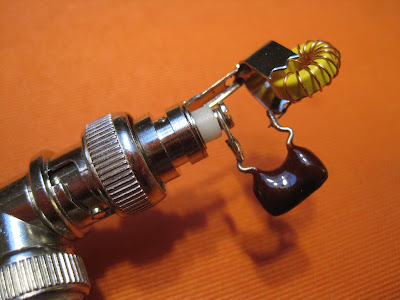OK, Hans thinks I have a FUSE fetish, but I'm also obsessed with using the QCX (Mini) on the "one lower" band without too much trouble. If I can get something for FREE ...
I don't want to modify the QCX inside (except for that FUSE! haha), partly scared to brick it , but also to keep it in its' "mint in box" condition.
One possible problem was the 2nd harmonic suppression when I use the 17m Mini on 20m (see my measurments page here ). I don't think it is a real problem if your QRP rig has a second harmonic 39 or 43 dB below the carrier, the potential interference will be very low anyway.
But ok, I had to investigate if something could be done about it, so I did a few experiments.
Of course, everything had to be as cheap and simple as possible.
First experiment : an outboard LPF for 20m
I happened to have two suitable BNC connectors, one a male PCB mount connector (found those in China), and a right angle female BNC (junkbox).
The filter is a simple 3-element LPF, existing of 2 x 180 pF capacitors, and 15 turns on a T37-6 (meaured L was 675 nH). I used wire from the QCX Mini kit, I still have plenty, since the supplied wire should be sufficient to wind a T1 for 80m.
I first prepared a small piece of PCB with a Dremel tool, and drilled all the holes.
TIP: to solder those connectors, you need a fair amount of heat. Put a matching BNC in them while soldering, especially those Chinese connectors don't contain a Teflon, but a simple white plastic insulator. How I know ? Well, you know ... hi.
An extra loss of 0.34 dB on 20 m was not so welcome, I had only 4 W on 20 m to start with ...
Still, let's try the LPF in combination with the QCX Mini ...
See picture at the top, the filter is very small, and fits nicely on the side of the QCX Mini.
I didn't put it in a box, but I could wrap it up in rubber tape if needed.
If I leave the filter plugged in by accident, and I start transmitting on 17m, I will get a high SWR and low output power, possibly ruining the QCX, and not making many QSO's.
OK, let's make one.
Using the nanoVNA for a quick check showed that I could easily tune the L/C to 28.1 MHz by shiftng a few turns on the ringcore (note that the nanoVNA was not calibrated, it shows 10 dB loss in the passband).
Now that is a mouthful, and also defies my principle of cheap and simple ... hi]
And what I got was a big surprise!
Not dramatic, but also not very good.



















